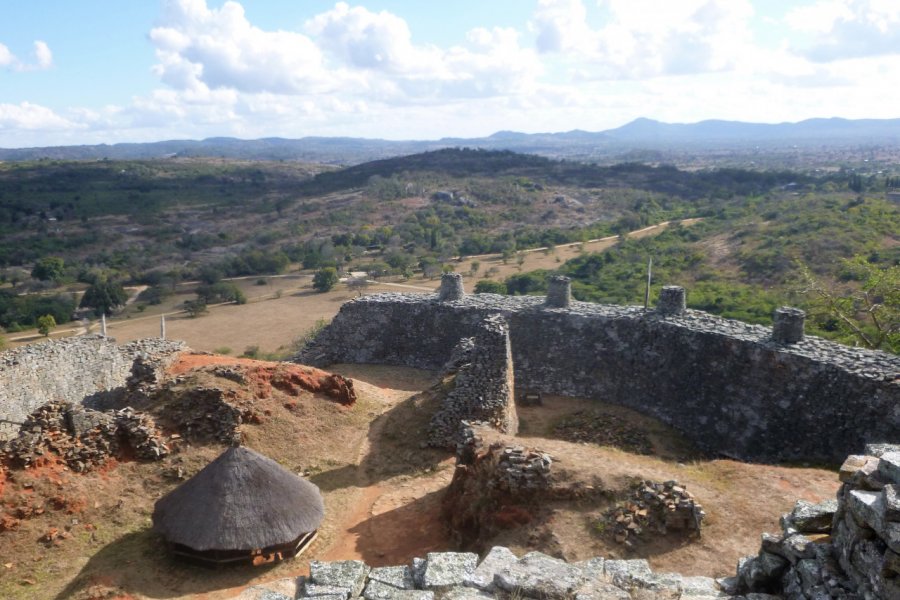Travel Guide Great Zimbabwe
Find an accommodation
Advertising
The Great Zimbabwe site covers approximately 80 ha, in the heart of the Mutirikwi Valley. It is managed by the National Museums and Monuments of Zimbabwe and has been designated a World Heritage Site by UNESCO. It is the largest and most impressive monument in sub-Saharan Africa. The ruins consist of a myriad of stone enclosures and walls, some of which are up to 11 m high and 6 m thick. Built in the Middle Ages, the city of Great Zimbabwe was home to more than 15,000 people and was probably the capital of a huge kingdom that spanned Zimbabwe and the surrounding countries (now Botswana, South Africa and Mozambique). Still in a very good state of preservation today, the large enclosures were for centuries the homes of tribal chiefs and rulers, who lived there surrounded by their families. These walls were built to show the power, wealth and prestige of the kingdom, rather than to protect it.The origins of Great Zimbabwe were for a long time the great subject of controversy that inflamed the conversations of ethnologists and archaeologists involved in research and excavations. For researchers, it was unthinkable to attribute the construction of such elaborate structures to natives, whom they had always seen living in mud huts. So, they went to look elsewhere for the origins of the city: some recognized the mark of the Phoenician civilization, while others concluded to the presence, as unsuspected as very old, of the Egyptians or the Hebrews in this remote part of southern Africa. However, in the 1930s, following the work undertaken at the beginning of the century by David Randall MacIver, the British woman Gertrude Caton-Thompson provided scientific, anthropological, archaeological and historical evidence of the Shona origin of the city. However, this evidence was not accepted until much later (at the time of independence!), as the white colonizers had great difficulty in accepting that the country could have been rich and prosperous without their presence. Nowadays, some continue to maintain the doubt and to make hover an aura of mystery around the city. According to the British archaeologist Gertrude Caton-Thompson, the first occupants of the site would have arrived in the 11th century. They were probably several independent groups who decided to gather for reasons of security and power. They settled on top of the largest hill and built traditional huts. As the wealth and power of this group of men increased from decade to decade, it was decided to build large stone compounds. Thus, the Hill Complex was born in the 13th century and served as the home of the successive kings of the city. In the 14th century, Great Zimbabwe reached its peak and the buildings called Great Enclosure and Valley Enclosure were erected. The city became an extremely prestigious political, religious and commercial capital and exerted its influence for hundreds of miles around. This power, partly acquired through livestock and good economic management, was also due to a true mastery of trade and commerce. Although it had no natural minerals, Great Zimbabwe became the main trading center of an empire stretching over 100,000 square kilometers between the Limpopo and Zambezi rivers. Gold and ivory were even brought from central southern Africa to the eastern coasts, and from there transported to Arabia, India and probably even China! In the 15th century, however, the city and its surroundings gradually became too small for the number of inhabitants (about 15,000 to 20,000 people). Weakened by internal quarrels and by a depletion of its natural resources, the fabulous empire of Great Zimbabwe declined rapidly. Its inhabitants left in small groups and settled all over the country, where there are more than 150 sites with similar architecture: ruins of Khami, Danangombe, Naletale in the west, vestiges of the Eastern Highlands, etc. In the 16th century, when the Portuguese arrived on the site where so many powerful rulers had reigned, it was almost deserted... The city was however taken over soon after by the Nemanwa dynasty, which remained there until the end of the 18th century, when it was replaced by the Mugabe dynasty. In 1834, the Mugabe dynasty was displaced by the Nguni. But at the end of the 19th century, when Adam Renders (an American-German hunter) discovered the city, it was in ruins. Although abandoned and deserted during colonization, the city of Great Zimbabwe continued to exert an incredible power of fascination on the country's inhabitants. Considered the soul and pride of the nation, it gave its name to the country at independence (the name Zimbabwe is said to come from the expression shona dzimba dza mabwe which means "great stone houses").
Suggested addresses Great Zimbabwe
Weather at the moment
Advertising
Organize your trip with our partners Great Zimbabwe
Transportation
Book your plane tickets
Car Rental
Boat rental
Accommodation & stays
Find a hotel
Holiday rental
Find your campsite
Tailor-made trip
Immersion travel
Services / On site
Activities & visits
Find a doctor
Find unique Stay Offers with our Partners
Pictures and images Great Zimbabwe
Other destinations nearby Great Zimbabwe
5 km away




